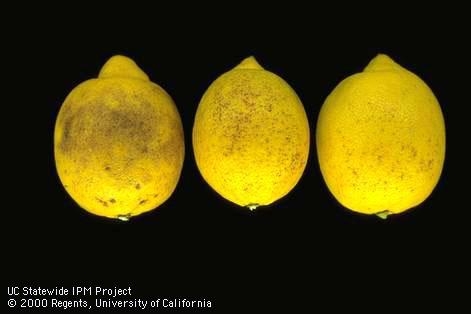How to Manage PestsUC Pest Management Guidelines
 I have had a number of requests to identify fruit spotting on lemons. It turns out to be Septoria fungus which can show up on leaves, stems and fruit. The key to this is to make sure there is a fungicide on the tree in the fall before the wet weather kicks in I have had a number of requests to identify fruit spotting on lemons. It turns out to be Septoria fungus which can show up on leaves, stems and fruit. The key to this is to make sure there is a fungicide on the tree in the fall before the wet weather kicks inCitrusSeptoria SpotPathogen: Septoria citri(Reviewed 9/08, updated 9/08) In this Guideline: SymptomsEarly symptoms of Septoria spot appear as small, light tan to reddish brown pits on fruit, 0.04 to 0.08 inch (1 to 2 mm) in diameter, which usually do not extend beyond the oil-bearing tissue. Advanced lesions are blackish, sunken, extend into the albedo (white spongy inner part of rind), and are up to 0.8 to 1.2 inch (20 to 30 mm) in diameter. Dark brown to black fruiting bodies often develop in these lesions, which usually do not extend beyond the oil-bearing tissue. The spots are much more conspicuous after the fruit has changed from green to yellow or orange. Small spots may develop into large, brown blotches during storage or long-distance transportation. Septoria citri may also cause similar spotting on leaves or twigs that are weakened by frost or pests. Comments on the DiseaseThe Septoria fungus causes spotting of Valencia oranges, late-season navel oranges, and occasionally of lemons and grapefruit. It occurs in the San Joaquin Valley and interior districts of southern California during cool, moist weather. Infections begin when Septoria conidia are transported throughout the tree by rainfall. The spores germinate with additional moisture from rain or dews and commonly infect cold-injured fruit tissue and mechanical injuries. The damage to the rind lowers the grade of the fruit and results in culling. Septoria spot may be confused with copper injury and other abiotic and biotic agents. ManagementApply a preventive copper spray in late fall or early winter, just before or after the first rain. In years with heavy rainfall, additional applications may be necessary. For California oranges (Navels and Valencias) shipped to Korea:
|
